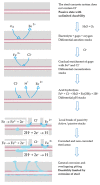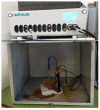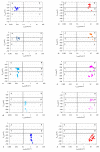Electrochemical Study of Clean and Pre-Corroded Reinforcements Embedded in Mortar Samples with Variable Amounts of Chloride Ions
- PMID: 34832287
- PMCID: PMC8622930
- DOI: 10.3390/ma14226883
Electrochemical Study of Clean and Pre-Corroded Reinforcements Embedded in Mortar Samples with Variable Amounts of Chloride Ions
Abstract
The present study investigates the possibility of re-surfacing previously corroded reinforcements and the suitability of the two electrochemical techniques that are widely used to determine the state of corrosion of steel (the corrosion potential Ecorr and the corrosion rate icorr). In order to test this, 32 pre-corroded B500SD reinforcing steel bars have been used for one year, where half of the bars have been cleaned to eliminate corrosion products. The other half have been maintained with the generated corrosion products. Subsequently, the bars have been embedded in cement mortar samples with variable amounts of chloride ion, and Ecorr and icorr have been measured for 250 days. The results showed that it is not possible to rework the reinforcement without removing corrosion products and that it is not possible to predict the passive or active state of steel by measuring Ecorr only.
Keywords: corrosion; electrochemical techniques; reinforcement; repassivation.
Conflict of interest statement
The authors declare no conflict of interest.
Figures











References
-
- Slater J.E. Corrosion of Metals in Association with Concrete. Volume 818 ASTM-STP; Philadelphia, PA, USA: 1983.
-
- Flis J., Pickering H.W., Osseo-Asare K. Interpretation of Impedance Data for Reinforcing Steel in Alcaline Solutions Containing Chlorides and Acetates. Electrochim. Acta. 1998;43:1921–1929. doi: 10.1016/S0013-4686(97)10004-4. - DOI
-
- Page C.L. Mechanism of corrosion protection in reinforced concrete marine structures. Nature. 1975;258:514–515. doi: 10.1038/258514a0. - DOI
-
- Hope B.B., Page J.A., Ip A.K.C. Corrosion rates of steel in concrete. Cem. Concr. Res. 1986;16:771–781. doi: 10.1016/0008-8846(86)90051-7. - DOI
-
- Federal Highway Administration . 6 FHWA Research Engineer Wins Arthur S. Flemming Award Promoted Advanced Bridge Inspection Technologies. Federal Highway Administration; Washington, DC, USA: 2001.
LinkOut - more resources
Full Text Sources

